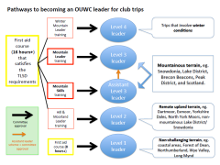Get involved with leading walks on OUWC trips!
The Club is always in need of new leaders at all levels. The courses outlined below cater for a wide variety of experience and interests. Leading on trips is a rewarding experience, and, of course, all of these qualifications/experience count for something in the real world. Please ask the Training Officer (training@ouwc.org ) if you’re not sure what’s for you! Further information on how our trips and leadership structure work may be found in the Trip Leader Safety Document.
N.B. The leader requirements were amended at the Michaelmas Term 2014 TGM to relax some of the course requirements.
N.B. For leading on Local Walks you only need to have been on a Local Walk before – see the Local Walks information page.
Training courses organized by OUWC
First aid course: to lead on trips (Weekend Trips and Minibus Day Trips) there is one basic thing that you need: a First Aid Course taken within the last three years. The club organizes a 16 hour (2 day) first aid course, usually annually near the beginning of Hilary term. The course is outdoors-oriented, and so ideal for anyone looking to lead trips in the future or those who wish to have a little first-aid knowledge for their own walking trips. No previous first aid training is required. Contact (training@ouwc.org) if interested.
Mountains Skills (MS) course: this is very useful for those wishing to lead on OUWC trips in mountainous terrain. See the subheadings “Level 3 OUWC Leader” and “The Assistant Leader Scheme” below.
1. Level 1 OUWC Leader
You may become a level 1 OUWC leader if you:
- Have an in-date first aid qualification (ie. course taken in the last 3 years) from any course that lasted at least 8 hours. Requalifications are also acceptable.
- Have approval by the OUWC committee.
This means you may lead on trips that involve walking on level 1 terrain (coastal and other non-remote areas): for example Cornwall, Gower, South Coast, Pembrokeshire, Northumberland, Long Mynd, Malvern Hills, Mendip Hills, Stiperstones, Wye Valley, Forest of Dean and New Forest are all common destinations that you could lead walks in.
2. Level 2 OUWC Leader
You may become a level 2 leader if you:
- Have an in-date first aid qualification from a course that lasted at least 16 hours, was outdoor-oriented and contained some element of assessment. In addition, there are some specific content requirements – see Appendix A4 of the Trip Leader Safety Document (TLSD). The OUWC-organised first aid course is very appropriate.
- Have completed MLTUK Hill and Moorland Leader (HML) Training and/or assessment. This course covers the skills you’ll need to take groups out on the hills, including navigation, safety, weather, and access. It’s great for those who would like to lead but don’t fancy ropework or anything too mountainous! You should have some experience of walking in areas like the above.
- Have approval by the OUWC committee.
This means you may lead on trips that involve walking on level 2 terrain (remote upland, but not mountainous): for example Dartmoor, Exmoor, Yorkshire Dales, North York Moors and non-mountainous parts of Snowdonia, the Lake District and Scotland.
3. Level 3 OUWC Leader
You may become a level 3 leader if you:
- Have a first aid qualification that matches the requirements outlined for becoming a level 2 leader (see above)
- Have completed either of these:
- MLTUK Mountain Leader (ML) Training and/or assessment. The ML course covers the whole range of skills including ropework, steep ground and river crossings. It’s best for those with a reasonable level of hillwalking experience.
- Mountain Skills (MS) Training and OUWC’s assistant leader scheme (see bottom of page).
- Have approval by the OUWC committee.
This means you may lead on trips that involve wild camping and/or walking on level 3 terrain (mountainous): for example Snowdonia, the Lake District, the Brecon Beacons, the Peak District and Scotland.
4. Level 4 OUWC Leader
You may become a level 4 leader if you:
- Have a first aid qualification that matches the requirements outlined for becoming a level 2 leader (see above)
- Have completed MLTUK Winter Mountain Leader (WML) Training and/or assessment
- Have approval by the OUWC committee.
This means you may lead on trips that involve winter conditions, meaning there is significantly snowy or icy terrain or substantial snowfall forecast.
The Assistant Leader Scheme
This was introduced at the TGM of Michaelmas Term 2014, to make it easier to become a level 3 OUWC leader. See the TGM minutes on this page, which describe the changes to the Trip Leader Safety Document (TLSD) that were made. The below is adapted from the new TLSD:
Any member of the club who has completed the Mountain Skills Course is eligible to become an assistant leader with the club. As with full leaders, all assistant leaders must be approved by committee, in addition to holding a first aid qualification that matches the requirements outlined for becoming a level 2 leader (see above). The responsibilities of an assistant leader are the same as those of a full leader.
An assistant leader, or group of assistant leaders, should not lead a planned walk without the presence of a full leader in the group.
After a minimum of 2 trips as an assistant leader (both of which must be on terrain of level 2 or above, of which at least one must be on level 3 terrain) the assistant leader is eligible to become a full level 3 leader. This requires committee approval in the same manner as all other leadership approvals (see above). Once full leader status has been granted, the leader has the same status as if they were an ML trained full leader, with the exception of not being permitted to lead on scrambles.



